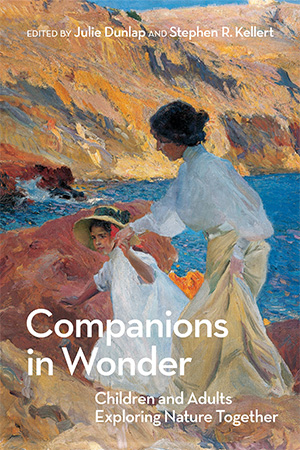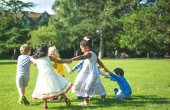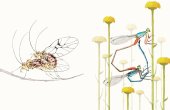Grandma’s ‘Bawena’: On the Kinship of Plants and People

The dark creases and lines on my Grandma’s face deepened as she smiled at my eagerness to learn about plant medicine. To my young mind, she seemed the perfect Grandma. Her white hair contrasted with her dark brown skin. The brightness of the sun deepened the wrinkles and creases on her face. She cooked the best cactus fruit jam. She always had cookies around when I came to visit. And she seemed to know everything about the land.

One day in our yard that was dotted with herbs and fruit trees, I watched her bend over to pick a sprig of bawena — spearmint — and hold it out for me to smell. Her old faded cotton dress with the flower print outlined her frail 80-year-old frame. Her full set of teeth glistened as she smiled, watching me enjoy the scent. Then in a voice made scratchy from smoking, she explained, “That is what bawena does to your stomach. It makes it smile.” I cannot forget the many times when my Grandma or mother rescued my upset stomach with some hot tea of bawena. Always, after just one cup, my insides would begin to smile again, ready for more food that I probably shouldn’t eat.
I understand now what my Grandma and mother, as well as my grandfather and other family members, were teaching me. They introduced me not only to plant knowledge but also to a frame through which I place myself into my environment and universe. I learned the names of plants, their uses, and their place in Rarámuri culture, philosophy, and cosmology. I understood them to be relatives and living beings with emotions and lives of their own. I learned that they are part of my life as well and that I should always care for them. In short, my family led me into the way of being a Rarámuri — a human being who walks well in the sun.
The concrete concept of people is mapped onto the more abstract one of plants that can breathe, play, maintain family relationships, and have emotions.
My grandparents’ souls now rest in the Milky Way with the other Rarámuri spirits who have departed this earth. But their lessons live on in my memory. I recall my Grandma’s smiling face and her short shuffling gait. If I am ill and drinking a steaming mug of bawena, I hear her scratchy voice, describing the uses of other plants from our yard and the land.
The plant knowledge I learned from my family was one aspect of a trove of culturally accumulated ecological knowledge. When my relatives introduced me to individual plants, they also introduced my kinship to the plants and to the land from where they and we emerged. They were introducing me to other relatives. Through this way of knowing, especially with regard to kinship, I realized a comfort and a sense of security that I was bound to everything around me in a reciprocal relationship.
The richest memories of my family are associated with plants. I frequently remember the seasonings my grandmother, mother, and aunts lovingly added to our meals. Epazote, cilantro, salvia, yerba buena, and chile pequin embodied the mural of flavors expressed on the table. These foods were eaten at home but were also central figures at fiestas, weddings, and other gatherings. I recall the many plant-related lessons in my Grandma’s herb house. It was a latticed structure filled with hanging dried and living plants. The roof was no longer visible through the layers of vines that draped over the eaves to the ground. On hot days, the interior would be nearly10 degrees cooler than outside. Inside, Grandma ground her herbs for cooking and for medicines on an old metate. I would often visit her and enjoy the many scents and aromas. It was during these times that she told me about the lives of plants and their characteristics. She described the relationships plants had with each other. She taught me that the plants were not only plants but were people, too. Some were Rarámuri, while others were Apaches and non-Indians.
When I was older, my grandfather introduced me to plants while we shooed away crows and other critters from the corn, beans, and chilis growing in his large garden. We would sit in the shade under his fruit trees, whittling and enjoying the outside while Grandfather retold short bits of traditional knowledge. From many of my immediate relatives, I gained scores of plant knowledge. It is difficult now to brew a cup of some medicinal herb for myself or for my children without picturing the specific time someone in my family introduced me to that particular remedy.
In most cases, I consumed the remedies as a result of something I should not have eaten. My cousins and I were erstwhile urban wildcrafters. We roamed our communities in constant search of something to do while taking advantage of all the available and free plants to munch. We sucked on a succulent grass with yellow flowers we called lemon grass. Its juices resembled the tartness of real lemons. We found bushes full of red, juicy, and semisweet berries and filled ourselves to capacity. These and other plant foods became our emergency stores for short treks that we imagined were epic adventures. Eventually, we encountered a plant we should not have eaten. Fortunately for us, we were related to wonderful and forgiving herbalists who could come to our stomachs’ rescue.
Today, as an ethnobotanist, I realize that plants are one of the many ingredients from nature that are the rudimentary materials of human metaphors, stories, mental spaces, cultural models, language, thought, and traditional ecological knowledge. Humans contemplate their landscape and attempt to express what is seen. Our expressions rely on cultural models that embody unique representations of place and relationships. The representations are verbally expressed in metaphors and prototypes and nonverbally expressed in mental spaces of the local environment. The metaphors and prototypes color the language and discourse and become part of the cultural history that describes how the place was created, how the people arrived, and how the people should sustain their niche in this place. Language and mental operations encode the centuries-old ways of conserving the land and the plants, ensuring the survival of nature and the survival of the culture.
It is understood that a person who harms the natural world also harms himself.
The names for plants are markers of our cultural sensitivity to the ecology of the land and to how our culture has embodied that ecological knowledge into our cognitive workings. In addition, cultural references to plant locations, the best sites for plant harvesting, and cultural history add further evidence of how ecological practices have been shaped by the bioregion.
Traditional ecological knowledge provides a basis for understanding culture and for understanding the influence the bioregion has on the history, social organization, and religious and aesthetic components of culture. From methods of land management to the application of plant medicines, from understanding the properties of small habitat ecologies to the reflection of ecology in their language, they demonstrate a way of knowing that recognizes that their actions as humans affect the entire ecosystem. Divorced from its bioregion, culture loses meaning. The interplay between the people, their minds, and the plants can be revealed only by taking the bioregion into consideration. In this work, the elements of plants, landscape, language, and culture merge. They can exist as separate entities but will coalesce into a kincentric unity.
The Rarámuri homeland is the southeastern flank of the Sierra Madres of Chihuahua, Mexico. For centuries, we have maintained a direct connection and relationship with a rugged mountain range that is perceived as the spine of the earth. In many ways, the mountain range is also the spine of our culture. The land shapes our lives. It is a place where human ecological interactions unfold daily.
These interactions are expressed in the language of the place. The Rarámuri speak of the land as the place of nurturing — gawiwachi. Gawi refers to the mountain ridge. Wa means to ripen and to help one reach maturity. Chi is a derivative of place and a noun ending. Ecological issues dominate our everyday existence. This is because the land is thought of as a kindred relative. The land is an important element in a bioregion filled with interconnecting niches, one of which the Rarámuri occupy.
In “Yellow Woman and Beauty of the Spirit,” Leslie Marmon Silko elegantly expresses how indigenous people in North America know that life is viable only when humans view their surroundings as kin. Their mutual roles are essential to their survival. To many indigenous people, this awareness unfolds after years of listening to and recalling stories from elders about the land. Silko, who is from Laguna pueblo, notes, “I carried with me the feeling I’d acquired from listening to the old stories, that the land all around me was teeming with creatures that were related to human beings and to me.”
Silko says that human beings must maintain a complex relationship with “the surrounding natural world if they hope to survive in [it].” To Silko, humans could not have “emerged into this world without the aid of antelope and badger.” The sustained living in the arid region of the Southwest could not have been viable without the recognition that humans are “sisters and brothers to the badger, antelope, clay, yucca, and sun.” It was not until they reached this recognition that the Laguna people could “emerge.”
In simplistic ecological terms, the earth exists as a functioning unit that can be reduced to smaller, self-contained entities referred to as ecosystems — self-sufficient communities of interacting organisms and their abiotic environments. Interactions are the commerce of ecosystem functioning. Without the correct mix of essential elements, the ecosystem would collapse. The elements comprise the animals, plants, fungi, insects, soil compositions, and chemicals unique to the system. Indigenous cultures of North America include human communities in their cultural equations of interacting ecosystems as one aspect of the complexity of life. The cognitive model of nature among the indigenous people of North America is founded on the perception of the natural elements of land, animals, insects, and plants as relatives. To indigenous people, humans are at an equal standing with the rest of the natural world with whom they are kindred. In addition, indigenous people believe that the complex interactions that result from this relationship enhance and preserve the ecosystem. Indigenous kincentricity with the natural world can also be viewed as an indigenous kincentric ecology.
The Rarámuri believe that we live interdependently with all forms of life. Our spiritual, physical, social, and mental health depends on the ability to live harmoniously with the natural world. Indigenous identity, language, land base, beliefs, and history are personifications of culture that regulate and manifest the health of the human and natural worlds. It is understood that a person who harms the natural world also harms himself.
History, identity, language, land base, and beliefs connect, secure, and regulate the human and nature relationship. Rarámuri history does not remain in a linear past. History is continuous and, more important, contextual. Cultural history includes the origins of humans and nature. Like many cultures, our origins are a result of relationships to animals, plants, and all nature. The Abenaki believe they were created from ash trees. The Lenape tell that humans sprang from a great tree. The Mayans believe they came from corn. The Hopi owe their emergence into this world to a spider, a spruce tree, a pine, and a stalk of reed that were used as ladders through the sipapu into the fourth world.
The concepts of identity and language are connected to Rarámuri concepts of self. Words shape thought. Thought is an expression of spirit. Both humans and other life forms are essentially spirit and matter, and both are manifestations of the interdependency of humans and nature. Self-identity is a result of a developed relationship to the environment as it is perceived by the culture. Cultural perception, language, and thought are related to both the land and cultural histories.
To the Rarámuri, beliefs form and explain the relationship. Beliefs help people recognize their links to the natural world and their responsibility to ensure its survival. People are not truly connected to the natural world or to their culture if they do not maintain physical, social, spiritual, and mental health. Together they form the breath of life — iwigara. Breath is the matter and energy that the Rarámuri believe moves in all living things. Maintaining a balanced and pure human breath also ensures the purity and health of the breath of the natural world.
The Abenaki believe they were created from ash trees. The Lenape tell that humans sprang from a great tree. The Mayans believe they came from corn.
With the awareness that one’s breath is shared by all surrounding life, that one’s cultural emergence was possibly caused by some of the life forms around one’s environment, and that one is responsible for a mutual survival, it becomes apparent that all life is related to you. Nature shares a kinship with you and with all humans, as does a family or tribe. A reciprocal relationship has been fostered with the realization that humans affect nature and nature affects humans. This awareness influences Rarámuri interactions with the environment. These interactions and cultural practices of living within a place are manifestations of kincentric ecology. This kincentric awareness fosters a standing metaphor among the Rarámuri that perceives plants as people.
Plant-related expressions encountered in discourse and in ceremonial songs concerning agriculture and plants as humans also reveal those same relationships unfolding into the heart of Rarámuri kincentricity and the cultural application of traditional ecological knowledge. What emerges is that in ceremonial songs kincentricity precipitates from the Rarámuri metaphor that plants are people. The concrete concept of people is mapped onto the more abstract one of plants that can breathe, play, maintain family relationships, and have emotions. With this realization, plants are as important to the Rarámuri as are our nonplant relatives. There is little distinction between our world and that of nonhumans. We all share the same breath. I am the mint tea, the bawena, that Grandma used to offer to soothe my ailing.
Enrique Salmón is an anthropologist and ethnobiologist, studying his family’s own Rarámuri culture and the role of plants in Rarámuri medicine and religion. He is the author of “Eating the Landscape” (University of Arizona Press) and “Iwígara” (Workman Publishing). This article is excerpted from the volume “Companions in Wonder.”




